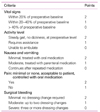Abstract
Four major factors affecting anesthetic choices in surgery include the requirements of surgery (including type and location), anesthesiologist's experience and expertise, patient's preference, and the surgeon's preference. Especially, the type and location of surgical procedure may limit anesthetic techniques and choice of anesthetic agents. Available anesthetic techniques consist of three basic options: regional anesthesia, monitored anesthesia care (MAC), and general anesthesia. Recent advances in nerve stimulators and ultrasound guidance devices help to make regional blocks more successful with less complications. MAC is increasingly used with given advantages of supplying sedation, anxiolysis, additive analgesia, and improved safety to patients. Remarkable advances in general anesthesia include total intravenous anesthesia (TIVA) and fast-track anesthesia to use drugs with rapid action and short duration including propofol, desflurane, and sevoflurane, and advanced equipments such as target-controlled infusion pumps and monitoring devices of anesthetic depth. Advances in medical technology and pharmacology will continue to develop newer anesthetic agents, techniques, and patterns.
Figures and Tables
Table 3
Procedures that can be performed with MAC and indications for anxiety control, sedation and analgesia in each procedure (7)

References
2. Hadzic A, Vloka J, Hadzic N, Thys DM, Santos AC. Nerve stimulators used for peripheral nerve blocks vary in their electrical characteristics. Anesthesiology. 2003. 98:969–974.

3. Marhofer P, Chan VW. Ultrasound-guided regional anesthesia: current concepts and future trends. Anesth Analg. 2007. 104:1265–1269.

4. Liu SS, Salinas FV. Continuous plexus and peripheral nerve blocks for postoperative analgesia. Anesth. Analg. 2003. 96:263–272.

5. Rosencher N, Bonnet MP, Sessler DI. Selected new antithrombotic agents and neuraxial anaesthesia for major orthopaedic surgery: management strategies. Anaesthesia. 2007. 62:1154–1160.

6. American Society of Anesthesiologists. ASA updates its position on monitored anesthesia care. ASA Newsletter. 1998. 62.
7. Ghisi D, Fanelli A, Tosi M, Nuzzi M, Fanelli G. Monitored anesthesia care. Minerva Anestesiol. 2005. 71:533–538.
9. Aono J, Ueda W, Mamiya K, Takimoto E, Manabe M. Greater incidence of delirium during recovery from sevoflurane anesthesia in preschool boys. Anesthesiology. 1997. 87:1298–1300.

10. Voepel-Lewis T, Malviya S, Tait AR. A prospective cohort study of emergence agitation in the pediatric postanesthesia care unit. Anesth Analg. 2003. 96:1625–1630.

11. Grottke O, Dietrich PJ, Wiegels S, Wappler F. Intraoperative wake-up test and postoperative emergence in patients undergoing spinal surgery: a comparison of intravenous and inhaled anesthetic techniques using short-acting anesthetics. Anesth Analg. 2004. 99:1521–1527.

12. Ahlen K, Buckley CJ, Goodale DB, Pulsford AH. The "propofol infusion syndrome": The facts, their interpretation and implications for patient care. Eur J Anaesthesiol. 2006. 23:990–998.

14. Martin PH, Murthy BV, Petros AJ. Metabolic, biochemical and haemodynamic effects of infusion of propofol for long-term sedation of children undergoing intensive care. Br J Anaesth. 1997. 79:276–279.

15. Cornfield DN, Tegtmeyer K, Nelson MD, Milla CE, Sweeney M. Continuous propofol infusion in 142 critically ill children. Pediatrics. 2002. 110:1177–1181.





 PDF
PDF ePub
ePub Citation
Citation Print
Print







 XML Download
XML Download